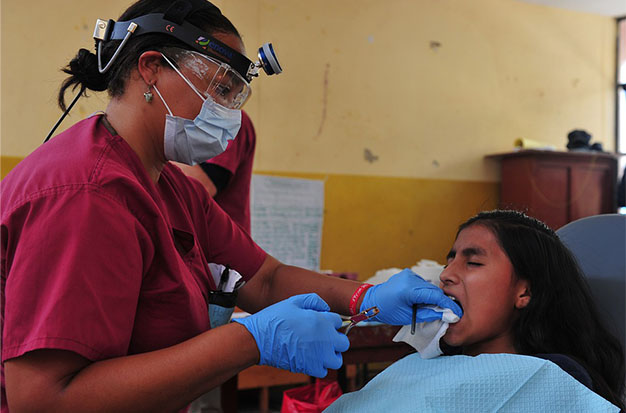
How Long To Keep Gauze In After Tooth Extraction?
You will almost certainly experience some bleeding right away following your tooth extraction surgery. And that’s normal; in fact, your dentist will cover the socket with gauze or another dressing to aid healing. But how do you know how long to keep gauze in after tooth extraction?
How Long Should Gauze Be Left In?
You need to keep gauze on the surgical area with some pressure (biting) for 30–45 minutes. If you are still bleeding after 30 to 45 minutes, remove the gauze and replace it with a fresh piece. It’s crucial to check that the gauze is placed directly on the surgical site. The bleeding should stop after applying firm pressure for another hour.
We sincerely hope that this lessens some of the anxiety you may be feeling as you recuperate from extraction surgery.
How Much Time Will I Bleed After Having A Tooth Pulled?
After surgery, bleeding is completely normal. After all, you recently had a tooth pulled, leaving a gap in your smile. The good news is that bleeding typically only lasts a short while. It usually lasts an hour or two, and in some circumstances, it might last a little longer.
Your dentist will apply pressure right away after the procedure and cover the area with gauze. This aids in stopping the bleeding. For the duration that the dressing is on, you should make an effort to maintain that pressure on the wound.
How Long Must You Keep Wearing Gauze After Having A Tooth Pulled?
After your surgery, you probably won’t need to use gauze for a long time.
After your surgery, keeping it there will aid in blood absorption, but the main objective is to exert pressure. In order to apply pressure directly to the wound, you should tightly bite your teeth.
You ought to keep the bandage in place as long as the area is gushing or bleeding. That usually takes an hour or so.
You should carefully remove the gauze and examine the socket to see how it is doing after an hour. You should get a fresh gauze dressing and put it in your mouth if it starts to ooze again. This is a good idea, and you should reassess it every hour until you no longer require it.
Inspect any blood that has been absorbed by the dressing when you do remove it. You are probably almost finished with it if it is mostly pinkish in color and fairly wet with saliva.
It’s possible that you haven’t been applying enough pressure if it’s still red and saturated.
If that’s the case, you should apply fresh gauze and make sure to bite down firmly to maintain sufficient pressure on the hole for a while.
When To Change Gauze After Tooth Removal?
As stated above, you should change the gauze every time you check on the dressing an hour after surgery until you are done. Don’t reapply a soiled dressing to the socket.
Make sure to wait the full hour before changing it because doing so might actually cause the clot to dislodge.
The nerves and bone in the area would be exposed if it were to dislodge. This can lead to an infection or dry socket and, ultimately, your healing time will be much longer. The most frequent and most painful side effect of tooth removal is a dry socket.
Aside from routine inspection, you should take off the dressing whenever you consume anything and replace it with a new one when you are done.
It’s also crucial to refrain from smoking and to initially only eat soft foods.

Additional Ways To Stop The Bleeding
You ought to be able to stop the bleeding by exerting sufficient pressure on the dressing.
After your dental surgery, there are other options you can try if you are unable to stop the bleeding.
For instance, you might try inserting a moist black tea bag into the opening. The tannic acid present in the bag can actually aid in improving the likelihood that a blood clot will form. The bleeding will stop once it does form.
When To Call Your Dentist?
Contact your dentist right away if you experience severe pain or bleeding that won’t stop. It’s normal to experience post-operative red discharge, but the day after surgery you shouldn’t require any dressing to cover the hole.
Additionally, you should see your dentist if you notice that the blood has stopped clotting or the clot has moved, as you may be at risk of developing a dry socket. There’s a chance that your dentist will advise you to take an antibiotic to prevent infection.
The Do’s And Don’ts After A Tooth Extraction
Extraction of teeth is what?
The phrase describes the painless extraction of a tooth or tooth roots with little trauma to the surrounding tissues so that the extraction socket wound heals properly and without any complications after the procedure. The first thing we want after any surgery is for it to heal properly, quickly, and smoothly. The majority of dental surgeons follow the standard post-operative instructions that are printed out and given to the patient. It is necessary to adhere to the dentist’s instructions. The incidence of infection and likelihood of a dry socket is decreased by carefully following all post-operative instructions. If aftercare instructions are not followed, complications may result, which could further delay healing. Following tooth extraction, there are some things you should and shouldn’t do.
Do’s:
- After tooth extraction, try to get some rest. Even though you might feel fantastic, wait at least 24 hours before exercising or engaging in too much activity. Keep your head on the pillow slightly upright while you’re sleeping.
- Allow a clot to form at the site of the tooth extraction so that it can protect the area and promote healing. Your dentist will give you a piece of gauze to bite on close to the extraction site after the procedure. For at least an hour after, make an effort to keep your bite firmly in place. In order to stop the bleeding, pressure will be applied to the wound. However, be careful not to chew on the piece of gauze. The longer you can keep it in place, the better, but depending on how much bleeding is occurring, change the gauze about every half hour. Once the clot has formed, it could dislodge the nerve endings and cause them to become exposed. Healing is delayed as a result of the nerves and capillaries contracting and spasming, which reduces the amount of vital blood flow. After the procedure, if the bleeding continues for a few hours, try applying a wet tea bag to the area. Black tea contains tannic acid, which aids in the clotting process.
- Apply an ice pack to the side of your face that underwent surgery. Reduced swelling is the goal here. While swelling is not a problem with straightforward extractions, it can happen after surgery when the cheeks need to be severely retracted. It’s possible that swelling following extraction won’t start right away; instead, it could develop over the course of a few days, peaking on the second or third day. The day of extraction is the best time to apply the ice pack because there is no real benefit after 24 hours. Applying ice packs for 1-2 hours should involve 15-minute on, and 15-minute off cycles.
Don’ts:
- Avoid smoking for at least 48 hours following tooth extraction. Following tooth extraction, 3–4 days, the chemicals in smoke may affect the clot, increasing the possibility of a dry socket.
- Avoid eating solid foods right away after: It’s best not to eat solids while you’re still numb. You can begin consuming solids once you can feel your jaw. Take soft and liquid foods after tooth extraction, such as soups, mashed potatoes, yogurt, milkshakes, smoothies, etc.
- Warm saline rinses are used to clean the extraction site because it is impossible to brush the socket. We add salt to the solution to make it isotonic and more like natural tissue fluid, which makes it less irritant than water. Twelve hours after the extraction, rinsing is typically advised. In order to clean and maintain the hygiene of that area, warm saline rinses are helpful.
- Take your medications as directed by your dentist: Take your medications as directed. If prescribed, antibiotics must be taken on a regular basis. Following tooth extraction, you should take painkillers and anti-inflammatory medications. It aids in reducing discomfort and swelling. You should contact your dentist if the pain persists after two days of tooth extraction and bleeding begins.
- Never take aspirin; ibuprofen is acceptable in its place. Aspirin, a blood thinner, delay clot formation, which prevents healing. Consult your dentist before taking any medications, and take the medications exactly as directed by your doctor.
- Avoid any kind of sucking: Following tooth extraction, one should refrain from smoking, drinking, and eating hard vegetables. Consider eating options that are soft and liquid, such as soups, mashed potatoes, yogurt, milkshakes, smoothies, etc. after tooth extraction. Avoid hot beverages, hot foods, sodas, and other things.
- Avoid inserting objects into the resulting gap: Although having a gap will feel a little odd for the first few days, you shouldn’t prod it with a toothpick or your tongue because doing so could slow down the healing process, and cause bleeding, or even result in a dry socket.
Summary
After removing a tooth, it’s best to cover the extraction site with gauze, but it’s also crucial to follow all of your dentist’s instructions. This will include:
- Taking any prescribed antibiotics
- Avoiding sucking motions, like smoking and drinking through a straw
- Eating soft foods to help your healing process
- Avoiding alcohol
- Keeping the area clean
The wound should begin to clot quickly if the dressing is kept in place, pressure is applied to it, and dressings are changed hourly. By doing this, you can return to normal while preventing an infection or dry socket.
It is best to contact your dentist if you experience pain, the clot doesn’t form, or the socket starts bleeding again several hours after the procedure.





Average Rating